Powerplants and marine environment / organisms
We analyze the environmental impact and effects of thermal and nuclear power plant water intake and discharge through on-site surveys, field experiments and laboratory experiments. We also develop technologies for predicting the impact of power plant construction and operation on coastal ecosystems. Technologies to prevent impairment of water intake caused by marine organisms are examined. Currently we have started to investigate the environmental impact of offshore wind farms and collect the data through laboratory experiments and field surveys.
Combined effects of thermal effluents and other factors
In the inner bay and inland sea, there is concern that power plant thermal effluents and other environmental factors may have a combined effect on marine organisms. We conducted experiments to verify the combined effects of water temperature rise, low salinity, low oxygen, and turbidity on marine animals such as black sea bream, Japanese whiting, red sea bream, asari clams, and Japanese oysters, and marine algae such as wakame, kurome, and gulfweed. It is clarified that sensitivity to the changes differed by species and developmental stages with various threshold level.
In recent years, the habitat range of herbivorous animals from the southern hemisphere has expanded, and increased grazing damage of large seaweed species (brown algae) and a reduction in seaweed beds has been pointed out. We currently investigate the effects of seawater temperature rise on the relationship between the feeding pressure of Mottled spinefoot and long-spined sea urchins which are representative herbivorous species and the productivity of large brown algae, such as Eisenia bicyclis and gulfweed, in a laboratory experiment.
(See https://www.kaiseiken.or.jp/aquarium/aquarium08.html) |
|
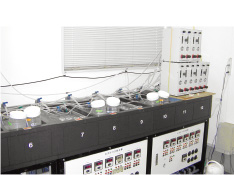 |
| High temperature/low oxygen concentration experiments |
| |
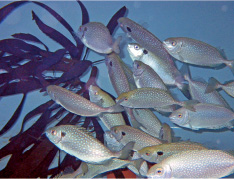 |
| Inter-species relationship experiment on Mottled spinefoot and Eisenia bicyclis |
|
| |
|
|
Behavioral response of fish to water temperature
In order to investigate the effect of seawater temperature rise due to power plant thermal effluent on fish coastal ecosystem, we examined the behavior of several species such as yellowtail, chum salmon, and cherry salmon using an experimental net cage installed in front of the thermal effluent outlet of a power plant (pictured on the right). We found that yellowtail prefer at deeper depths during the summer to avoid higher temperature near the sea surface, while in winter they are attracted to the effluent and mainly swim at the surface. We gained data for the better understanding of the reaction behavior characteristics of several fish species. |
|
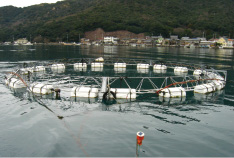 |
| Net cage installed in the thermal effluent discharge area |
|
| |
|
|
Field experiments to assess the effects of thermal effluents
In order to clarify the extent and degree of the effects of the thermal effluent on seaweed in the immediate vicinity of power plants, we installed test plates with juvenile seaweeds (wakame, Eisenia bicyclis, and gulfweed) at several locations with different temperatures, and observed the growth and maturation of the seaweed.
We confirmed the degree of effects on the growth and maturation of wakame, Eisenia bicyclis and gulfweed species by temperature rise of 3-5℃ and 2-3℃. |
|
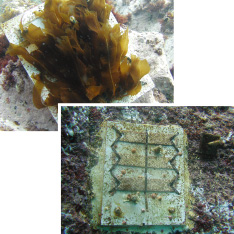 |
| Comparative photo of test plates |
|
| |
|
|
Development of survey prediction techniques for marine ecosystem impact assessments
We studied methods and procedures for surveys and predictions to assess the impact of the construction and operation of power plants on the coastal marine ecosystem (bottom left figure).
After information of interest species in marine ecosystems and environmental factors were databased, we constructed the prediction model to estimate the response of specific organisms to several environmental factors, and developed techniques to introduce the prediction data into GIS system. The figure on the bottom right shows an example of an analysis of the impact of a hypothetical power plant on one of the seaweed species of interest, Eisenia bicyclis (red: high impact, yellow: low impact). The red parts indicate extinction mainly due to land reclamation, but also indicate partial extinction in the immediate vicinity of the thermal effluent outlet. |
| |
 |
 |
 |
 |
Examination of survey methods for ecosystem
impact assessments |
|
Prediction of the scope of impact of the power plant
on Eisenia bicyclis |
|
| |
|
|
Technological development to control biofouling in the water intake systems
There are concerns that biofouling in the cooling water intake facilities of power plants reduce the heat exchange efficiency of condensers, etc. We conducted research to develop effective antifouling methods with low-impact on marine ecosystem through surveys of biofouling conditions at power plants and bioassay to verify the effects of chlorination. |
|
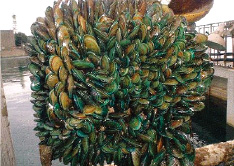 |
| Asian green mussels adhering to the test substrate |
|
| |
|
|
Initiatives involving the environmental impact assessment of offshore wind farms
Expectations for offshore wind power generation are increasing due to the introduction and expansion of renewable energy. In order to facilitate the deployment of offshore wind power, considering the impact on the marine environment, marine organisms and fisheries is one of the key issues to gain the understanding of fishermen and other existing users of the sea area, as well as local residents. Knowledge about the impact has been accumulated in Europe, where offshore wind farm has been developed at several areas. However, the impact in coastal waters is still largely unknown in Japan where the marine environment, the existing species, and the types of fisheries present are different from in Europe.
MERI already has lots of information on the effect of coastal development on the marine ecosystem and organisms through, the studies of pawer plants, and been collecting domestic and international information on marine environmental impact assessments and fisheries impact literature related to offshore wind farms. Based on these knowledge and experience, we can advise on planning environmental assessments and fisheries impact surveys that are suitable for the local marine environments and fisheries.
 |
 |
| Relationship between factors and potential impacts of offshore wind farm on fisheries |
|
| |
|
|
We also conduct research to clarify impacts of underwater sounds generated by the construction and operation of offshore wind farms on the marine ecosystems. *We exposed underwater noise at a frequency of 100 Hz on juvenile red sea bream in experimental tanks, and found that feeding behavior was temporarily suppressed at the start of exposure at a sound pressure level of 140 dB re 1 μPa. Such findings are considered to be useful for predicting the impact of underwater sounds on target organisms, and can be used for the marine environmental impact assessments and fisheries impact surveys at areas where offshore wind farms are scheduled to be constructed.
* Joint research with National Maritime Research Institute, National Institute of Maritime, Port and Aviation Technology (Grant-in-Aid for Scientific Research (JSPS) Basic Research (C) 15K00575) |
|
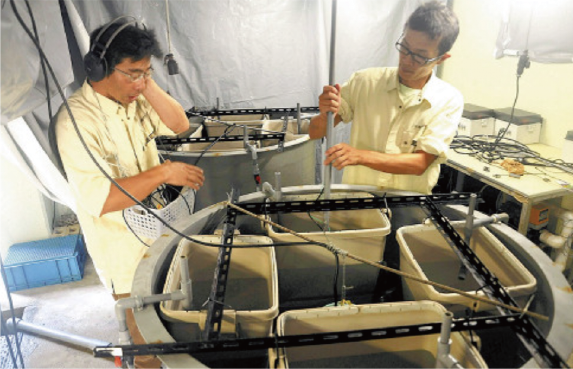 |
| Measurement of low-frequency underwater sounds in a test tank |
|
|